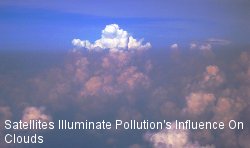Aerosols And Clouds

The Aerosol and Cloud Science Group's primary research objective is to understand fundamental processes relating to atmospheric aerosols, clouds, and their interactions, as well as their influences on the weather and climate systems.
The main science questions our group is focused to addressing include:
- What are the physical properties of different types of aerosols and clouds?
- What are the radiative processes and feedbacks of different types of aerosols and clouds?
- What are the aerosol-cloud-precipitation relationships and their impacts to climate system?
- How to improve the climate model representations of aerosols and clouds and their related processes and thus to improve predicting the societal impacts of future climate change?
Aerosols And Clouds: Missions and Projects
The group works on operating and developing remote sensing instrumentation for aerosol and cloud measurements, as well as theoretical and computational radiative transfer modeling, and retrievals of aerosol and cloud properties. The main JPL missions of the group are: Terra satellite’s Multiangle Imaging Spectro-Radiometer (MISR) experiment and Airborne Multiangle Spectro-Polarimetric Imager (AirMSPI). In addition, members of the group are actively conduct research for various satellite missions and projects including Aura MLS, CloudSat, and CALIPSO. These missions and projects provide key measurements of physical properties of different types of aerosols and clouds, and help scientists to study the radiative processes and feedbacks of these aerosols and clouds.
For more information, please see:
The scientists and technical staffs of the group are leading experts in several important areas related to atmospheric aerosols and clouds:
- Studying critical processes for multi-scale organization of tropical deep convective clouds − from the mesoscale systems, to the convectively coupled synoptic waves, and to the planetary-scale Madden-Julian Oscillation (MJO). This research addresses the questions related to convective cloud processes and feedbacks affecting tropical climate variability and their influences on extra-tropical weather and climate.
- Modeling small-scale processes turbulent transport. The main activity of this area includes large-eddy simulation (LES), which is fundamental for understanding boundary layer cloud process and its impacts to climate.
- Utilizing multi-platform satellite remote sensing data for climate model evaluation, analysis, and consolidating collaborations with climate modeling community. Many aerosol and cloud processes remain poorly represented in the present-day weather and climate models, thus this area of research helps model improvements and better weather and climate prediction.
- Global and regional Earth system modeling to investigate aerosol impacts on climate. The group has an in house NCAR CESM model, which has aerosol and cloud microphysics. The model simulations together with observational analysis help researchers to understand the aerosol-cloud-precipitation relationships and their impacts to climate system.